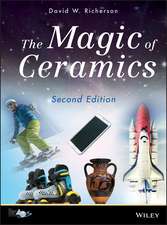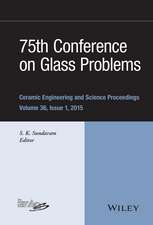Laboratories of Art: Alchemy and Art Technology from Antiquity to the 18th Century: Archimedes, cartea 37
Editat de Sven Dupréen Limba Engleză Hardback – 13 mai 2014
| Toate formatele și edițiile | Preț | Express |
|---|---|---|
| Paperback (1) | 925.32 lei 6-8 săpt. | |
| Springer International Publishing – 3 sep 2016 | 925.32 lei 6-8 săpt. | |
| Hardback (1) | 929.84 lei 6-8 săpt. | |
| Springer International Publishing – 13 mai 2014 | 929.84 lei 6-8 săpt. |
Din seria Archimedes
- 5%
 Preț: 893.68 lei
Preț: 893.68 lei - 18%
 Preț: 884.03 lei
Preț: 884.03 lei - 18%
 Preț: 772.32 lei
Preț: 772.32 lei -
 Preț: 375.96 lei
Preț: 375.96 lei - 18%
 Preț: 1802.33 lei
Preț: 1802.33 lei - 15%
 Preț: 633.00 lei
Preț: 633.00 lei - 18%
 Preț: 935.72 lei
Preț: 935.72 lei - 15%
 Preț: 634.91 lei
Preț: 634.91 lei - 15%
 Preț: 633.45 lei
Preț: 633.45 lei - 20%
 Preț: 577.17 lei
Preț: 577.17 lei - 18%
 Preț: 1089.33 lei
Preț: 1089.33 lei - 15%
 Preț: 635.73 lei
Preț: 635.73 lei - 18%
 Preț: 1091.36 lei
Preț: 1091.36 lei - 18%
 Preț: 1196.10 lei
Preț: 1196.10 lei - 18%
 Preț: 717.73 lei
Preț: 717.73 lei - 18%
 Preț: 1525.99 lei
Preț: 1525.99 lei - 18%
 Preț: 876.44 lei
Preț: 876.44 lei - 18%
 Preț: 763.79 lei
Preț: 763.79 lei - 18%
 Preț: 1194.08 lei
Preț: 1194.08 lei - 18%
 Preț: 1094.48 lei
Preț: 1094.48 lei - 18%
 Preț: 764.58 lei
Preț: 764.58 lei - 18%
 Preț: 979.02 lei
Preț: 979.02 lei - 15%
 Preț: 624.77 lei
Preț: 624.77 lei - 24%
 Preț: 1308.04 lei
Preț: 1308.04 lei - 18%
 Preț: 932.47 lei
Preț: 932.47 lei - 18%
 Preț: 1638.80 lei
Preț: 1638.80 lei - 18%
 Preț: 1096.02 lei
Preț: 1096.02 lei - 15%
 Preț: 634.74 lei
Preț: 634.74 lei
Preț: 929.84 lei
Preț vechi: 1133.95 lei
-18% Nou
Puncte Express: 1395
Preț estimativ în valută:
178.03€ • 185.39$ • 147.71£
178.03€ • 185.39$ • 147.71£
Carte tipărită la comandă
Livrare economică 14-28 februarie
Preluare comenzi: 021 569.72.76
Specificații
ISBN-13: 9783319050645
ISBN-10: 3319050648
Pagini: 224
Ilustrații: XXIII, 200 p. 47 illus., 34 illus. in color.
Dimensiuni: 155 x 235 x 20 mm
Greutate: 0.45 kg
Ediția:2014
Editura: Springer International Publishing
Colecția Springer
Seria Archimedes
Locul publicării:Cham, Switzerland
ISBN-10: 3319050648
Pagini: 224
Ilustrații: XXIII, 200 p. 47 illus., 34 illus. in color.
Dimensiuni: 155 x 235 x 20 mm
Greutate: 0.45 kg
Ediția:2014
Editura: Springer International Publishing
Colecția Springer
Seria Archimedes
Locul publicării:Cham, Switzerland
Public țintă
ResearchCuprins
About the Authors.- Introduction; Sven Dupré.- Chapter 1 The Alchemical Art of Dyeing: The Fourfold Division of Alchemy and the Enochian Tradition; Matteo Martelli.- Chapter 2 Transmission of Alchemical and Artistic Practices and Materials in German Mediaeval and Premodern Recipe Books; Sylvie Neven.- Chapter 3 Artisanal Processes and Epistemological Debate in the Works of Leonardo da Vinci and Vannoccio Biringuccio; Andrea Bernardoni.- Chapter 4 Artificial Interventions in the Natural Form of Things: Shared Mettallogenetical Concepts of Goldsmiths and Alchemists; Henrike Haug.- Chapter 5 The Laboratories of Art and Alchemy at the Uffizi Gallery in Renaissance Florence: Some Material Aspects; Fanny Kieffer.- Chapter 6 Material and Temporal Powers at the Casino San Marco (1574-1621); Marco Berretta.- Chapter 7 Goldsmiths and Chymists: The Activity of Artisans within Alchemical Circles; Lawrence M. Principe.- Chapter 8 Refutata per ignem: The Evidence for the Use of Thermal Analysisin Seventeenth Century European Ceramic Innovation; Morgan Wesley.
Recenzii
“This volume presents a multifaceted study of the complex, and sometimes blurred, relationship between art production and alchemical process, with a focus on artisans who utilized the agency of fire in the transformation of raw materials into objects of art, such as glassmakers, silver- and goldsmiths, and porcelain producers. … present stimulating new ventures into the subject of alchemy through their ruminations on skill and imagination. … excellent research and teaching resources that connect to a wide and diverse audience.” (Donna Bilak, Isis, Vol. 107 (3), September, 2016)
Textul de pe ultima copertă
This book explores the interconnections and differentiations between artisanal workshops and alchemical laboratories and between the arts and alchemy from Antiquity to the eighteenth century. In particular, it scrutinizes epistemic exchanges between producers of the arts and alchemists. In the fifteenth and sixteenth centuries the term laboratorium uniquely referred to workplaces in which ‘chemical’ operations were performed: smelting, combustion, distillation, dissolution, and precipitation. Artisanal workshops equipped with furnaces and fire in which ‘chemical’ operations were performed were also known as laboratories. Transmutational alchemy (the transmutation of all base metals into more noble ones, especially gold) was only one aspect of alchemy in the early modern period. The practice of alchemy was also about the chemical production of things--medicines, porcelain, dyes, and other products as well as precious metals--and about the knowledge of how to produce them. Thisbook uses examples such as the Uffizi to discuss how Renaissance courts established spaces where artisanal workshops and laboratories were brought together, thus facilitating the circulation of materials, people and knowledge between the worlds of craft (today’s decorative arts) and alchemy. Artisans became involved in alchemical pursuits beyond a shared material culture and some crafts relied on chemical expertise offered by scholars trained as alchemists. Above all, texts and books, products and symbols of scholarly culture played an increasingly important role in artisanal workshops. In these workplaces a sort of hybrid figure was at work. With one foot in artisanal and the other in scholarly culture this hybrid practitioner is impossible to categorize in the mutually exclusive categories of scholar and craftsman. By the seventeenth century the expertise of some glassmakers, silver- and goldsmiths and producers of porcelain was just as based in the worlds of alchemical and bookish learning as it was grounded in hands-on work in the laboratory. This book suggests that this shift in workshop culture facilitated the epistemic exchanges between alchemists and producers of the decorative arts.
Caracteristici
Includes accessibly written chapters on the widest range of visual and decorative arts by scholars of history of alchemy and chemistry High-quality images, sometimes of art objects shown here in print for the first time Includes references to art objects included in the exhibition on art and alchemy at the Museum Kunstpalast in Düsseldorf Includes supplementary material: sn.pub/extras










